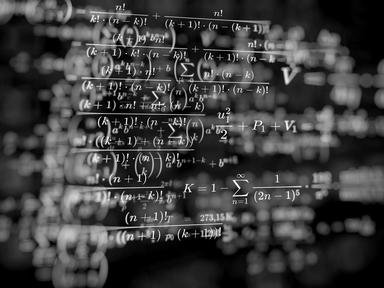Quiz Answer Key and Fun Facts
1. The gradient (or slope) of a line is a number that tells you the rate of its growth. A gradient of 100 would be a very steep line going upwards, whereas a line with gradient 1/100 is almost flat. A gradient of -1, or any other negative number, would indicate that the line is going down.
Without doing any calculations, we can tell that both of these lines have positive-valued gradients, because they are pointing upwards. We can also tell which line has a larger gradient. What color line is it?
2. To check you've got the hang of gradients, let's test with a couple more examples. Which of these terms correctly describes the gradient of this line?
3. It's not just lines that have gradients, but curves too. The value of the gradient may not be the same at every point on a curve: if the curve goes upwards and then downwards, then it'll have a positive gradient when it moves upwards, and a negative gradient in the downwards region.
On this graph, the curve has different gradient values at the three points labelled. The green point (A) has a negative gradient, because the curve is going downwards at that point, while the red (B) and blue (C) points have positive gradients as the curve is increasing. Which point, then, has the largest positive gradient value?
4. If we have a curve (in green) and a point on that curve (A, also in green), we can draw a tangent line. The tangent touches the curve just barely, at that particular point, not touching any of the immediately surrounding points on the curve.
Which of the lines is the tangent? (Click on the image to see the colors more clearly.)
5. One last question on gradients: if I move a line upwards, does its gradient change?
6. Integration is a calculation that helps you find areas. On this co-ordinate graph, the black square has an area of 1. Each square on this grid above the (horizontal) x-axis contributes an area of 1 towards the value we get from integration, but each square below the x-axis contributes an area of -1. So the green square has an area of -1.
I use integration to find the area under the red curve (and above the x-axis) between the x-values of 0 and 3. This is shaded in red. The (approximate) answer I get is one of the four numbers below. Which one must it be?
7. This red curve is called a sine wave because of its symmetries and repetitive pattern. When I integrate it between the x-values -3 and 0, I get the area in green. What value do I get?
8. Our last topic is limits. Shown on the graph is something that looks suspiciously like a straight line, except for one black point (A) where there is a discontinuity. Instead of a line, we will call it a "function". At A, it is undefined: the function has no value.
Even though the function doesn't have a value at A, it does have a limit. The limit is a number. If you approach the discontinuity from the left, you get closer and closer to this number, the y co-ordinate. If you approach the discontinuity from the right, you get closer and closer to the very same number.
So, what is the limit value as the function approaches the black dot from either direction?
9. On this graph, we see another function with a discontinuity - it makes a sudden jump down. Which of these statements about the limit value at the discontinuity is true?
10. Lastly, let's visit a topic not generally studied until university level: Rolle's theorem. A "theorem" is just a mathematical fact proven to be true.
With the graph as a guiding example, and our newfound knowledge of gradients, integration and limits, which of these completes the statement of Rolle's theorem: "if a (specific type of) function crosses the x-axis twice, then between these crossings..."
Source: Author
AdamM7
This quiz was reviewed by FunTrivia editor
WesleyCrusher before going online.
Any errors found in FunTrivia content are routinely corrected through our feedback system.
